Athena Review Vol. 5, no. 1
Records of Life: Fossils as Original Sources
20 Late Permian and Early Triassic Dicynodonts
Dicynodonts ("two dog-teeth") were small- to medium-sized therapsids who usually had only two upper canines. They are well represented in Late Permian faunal zones in the Karoo Basin of South Africa, and were a widely distributed group in the southern land areas of Gondwanaland (fig.1). Some groups survived the massive end-of-Permian extinction and lived into the Early Triassic. This section will have three parts, covering a) Late Permian Dicynodonts; b) the end-of Permian extinction; and c) Early Triassic Dicynodonts and related fauna.
Late Permian dicynodonts: variation and distribution.
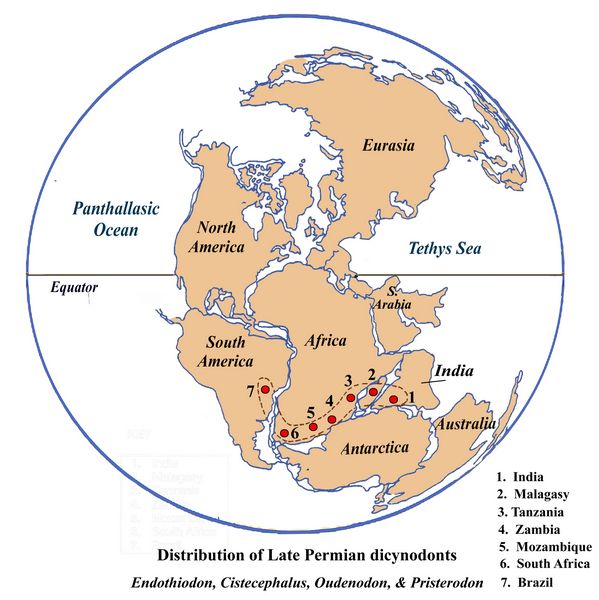 First appearing in the Middle
Permian zones of the Beaufort Group, Dicynodonts became the most successful
and abundant land vertebrates of the Late Permian, radiating into a
varety of niches in widespread regions as large, medium-sized, and
small herbivores, and short-limbed burrowers.
First appearing in the Middle
Permian zones of the Beaufort Group, Dicynodonts became the most successful
and abundant land vertebrates of the Late Permian, radiating into a
varety of niches in widespread regions as large, medium-sized, and
small herbivores, and short-limbed burrowers. Dicynodonts were first reported in 1845 by the geologist Andrew Geddes Bain from fossils he found during surveys of South Africa. In a letter published in Transactions of the Geological Society of London, Bain (1845) called them "bidentals" for their two prominent canines or tusks. The same year, Richard Owen named two South African species of dicynodonts as Dicynodon lacerticeps and Dicynodon bainii, later proposing the more general group name of Dicynodontia in 1860.
Fig.1: Late Permian Pangea, showing distribution of 4 dicynodonts (after Ray 1999).
Dicynodon ("two dog-teeth"), the type species of the dicynodonts, was a medium-sized, herbivorous therapsid about 1.2 meters long, with two prominent, tusk-like canines (fig.2). It probably cropped vegetation with a horny beak, much like a tortoise, while the tusks may have been used for digging up roots and tubers. The type species is Dicynodon lacerticeps, named by Owen (1845). Although over 160 species of Dicynodon have since been named from various Late Permian formations in Russia , China, India, and elsewhere, these have recently been drastically reduced to only a few species (Kammerer and Angielczyk 2009).
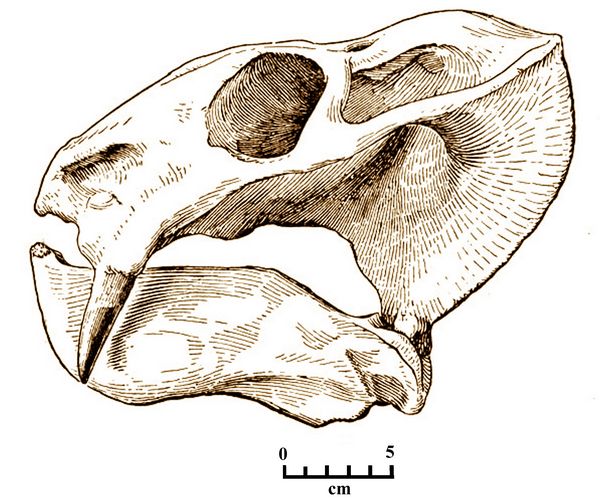
As members of the Synapsids, the single temporal opening of dicynodonts is greatly enlarged, supporting very powerful jaw muscles. Their dentition, while somewhat variable, was usually minimal. Many genera, including the type genus Dicynodon, had only their prominent upper canines. Some dicynodonts such as Oudenodon had no teeth at all; others, however, such as Pristerodon, had several post canine teeth for chewing, in addition to large canines. One widely distributed genus, Enthiodon, had two rows of 9-11 teeth on the palatine bones of its upper jaw, and matching teeth in its dentary or lower jaw bone, as described by Owen (1879). More consistently, the dentary processes of dicynodonts were made up of a horny, keratin covering on both the upper and lower jaws. This formed a beak-like appearance, resembling that of modern turtles.
Fig.2: Skull of Dicynodon.
Regarding their reproduction, it remains unknown whether dicynodonts laid eggs, as in reptiles, or had developed vivipary, as in mammals. The bony birth canal area between the pubis and ischium was large enough to allow the birth of live young, but could also have been useful in laying large eggs (King 1990). Some genera display sexual dimorphism, as shown by larger canine teeth in males.
The distribution map (fig.1) shows the areas in Gondowanaland where fossils of four widespread Late Permian dicynodont genera have been found (Ray 1999). These include Cistecephalus, Endothiodon, Pristerodon, and Oudenodon. Based on the nearly synonymous distribution pattern of the widespread conifer Glossopteris, these animals probably lived in wooded, well-watered, riverine settings.
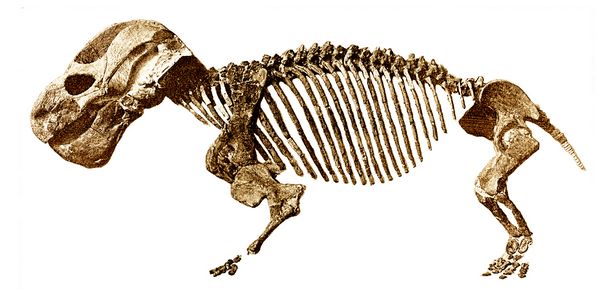 The
Late Permian dicynodont Endothiodon (fig.3) was
first described
by Owen (1879) for the Karoo region, with a skull and mandible,
including 11 teeth. A partial skeleton was
later recovered by Broom (1915) at Beaufort West in South Africa, dating from the
Late Permian Tatarian Age. Endothiodon augusticeps is one of the
species found in South Africa. Since then, Endothiodon has also
been found in Tanzania (Haughton 1932), Zambia (Mazin and King 1991),
Mozambique (King 1992), India (Kutty 1970), and Brazil (Boos et al.
2013).
The
Late Permian dicynodont Endothiodon (fig.3) was
first described
by Owen (1879) for the Karoo region, with a skull and mandible,
including 11 teeth. A partial skeleton was
later recovered by Broom (1915) at Beaufort West in South Africa, dating from the
Late Permian Tatarian Age. Endothiodon augusticeps is one of the
species found in South Africa. Since then, Endothiodon has also
been found in Tanzania (Haughton 1932), Zambia (Mazin and King 1991),
Mozambique (King 1992), India (Kutty 1970), and Brazil (Boos et al.
2013). Fig.3: Endothiodon skeleton (after Broom 1915; AMNH) .
The finding of Endothiodon in Brazil is particularly noteworthy, since it is the first dicynodont to be reported for the Permian of South America. A partial skull and associated lower jaw were discovered in the 1970s in a railway cut at Serra do Cadeado, in the Rio do Rasto Formation of Parana State (Barbarena and Araujo 1975). The Rio de Rasto Formation is dated in the Guadelupian Stage of the Middle Permian. The findings also show similarities with stratigraphic ranges of the Middle and Late Permian of both South Africa and Eastern Europe. Boos et al. (2013) have been able to demonstrate correlations of Brazil with deposits in India, Malawi, Mozambique, South Africa, Tanzania, Zambia, and Zimbabwe.
Pristerodon (fig.4) was first identified in South Africa, and described by T.H. Huxley in 1868. It has since been found in both India and Tanzania (Ray 1999). Pristerodon, whose skull an
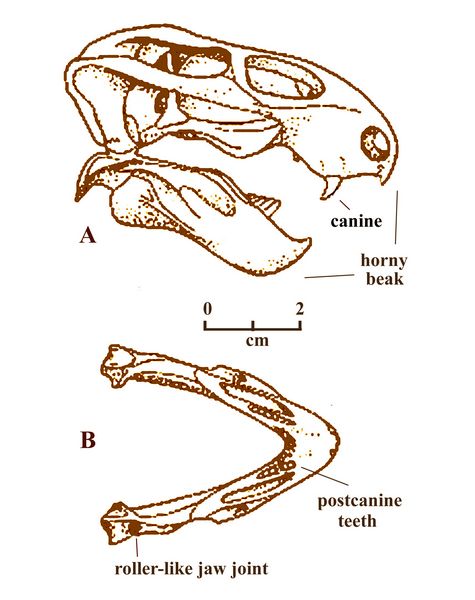 d likely associated muscles have been
studied in detail, had a skull 4-6 cm long, with a short snout. Unlike most other dicynodonts, Pristerodon retained six
pointed post-canine teeth on either side of its upper and lower jaws
(maxilla and dentary). The rest of the jaws were made of sharp
bone, probably covered with keratin or a horny surface (Benton 2005).
Pristerodon lived on vegetation which it snipped off with its horny
beak, then passed back to its cheek area for grinding with its
molars before swallowing.
d likely associated muscles have been
studied in detail, had a skull 4-6 cm long, with a short snout. Unlike most other dicynodonts, Pristerodon retained six
pointed post-canine teeth on either side of its upper and lower jaws
(maxilla and dentary). The rest of the jaws were made of sharp
bone, probably covered with keratin or a horny surface (Benton 2005).
Pristerodon lived on vegetation which it snipped off with its horny
beak, then passed back to its cheek area for grinding with its
molars before swallowing.Pristerodon's jaw was built as a flexible unit, able to slide back and forth while eating. The key chewing muscles included a 1) large lateral external adductor that contracted the jaw, running from the back of the skull (squamosal and quadratojugal bones) to a long ridge on the side of the dentary; 2) another jaw contractor, the medial external adductor that ran inside the zygomatic arch from the parietal bone at the top of the skull, to the top of the dentary; 3) a small pterygoidus muscle that pulled the jaw forward; and 4) the depressor mandibulae, which opened the jaw. This ran from the back of the skull (squamosal bone) to the retroarticular process, the part of the jaw behind the jaw joint (Benton 2005).
Fig.4: Pristerodon skull (A) and lower jaw (B), showing teeth (after Benton 2005)
Oudenodon (fig.5) is the type genus of the family Oudenodontidae, which also includes Cteniosaurus, Tropidostoma, and Rhachiocephalus. The Oudenodontidae family have a deep, thin walled cleft in the lower jaw for anchoring the horny platform. They had a very precise cutting and crushing surface between the beaks, where the rim of the maxilla was pointed downward to fit with the lower jaw symphesis. Oudenodon had no teeth at all. The skull was directed forwards, therefore, adapted to feeding at levels approximately 20-100 cm above the ground (King 1990). This shows a new level of diversification, away from substrate-feeding.
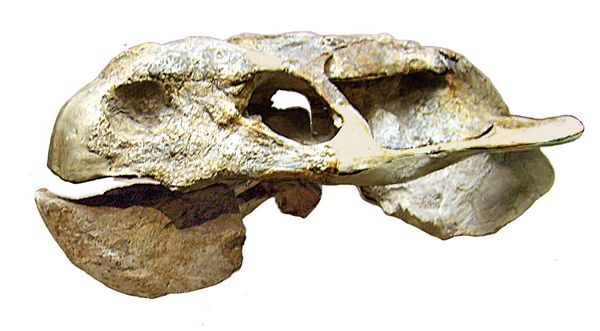 Fig.5: Oudenodon skull, showing beak-like jaws (Berlin Museum of Natural History)
Fig.5: Oudenodon skull, showing beak-like jaws (Berlin Museum of Natural History)Oudenodon was common throughout southern Africa during the Late Permian, and has also been found in India (Ray 1999; Bandyopadhyay 1999), Madagascar, and Zambia. Several known species of Oudenodon include O. bainii, the type species, and O. grandis from South Africa, and O. luangwensis from Zambia. Another species, O. sakamenensis, is the only therapsid yet known from Madagascar (Mazin and King 1991).
The end-of-Permian Mass Extinction
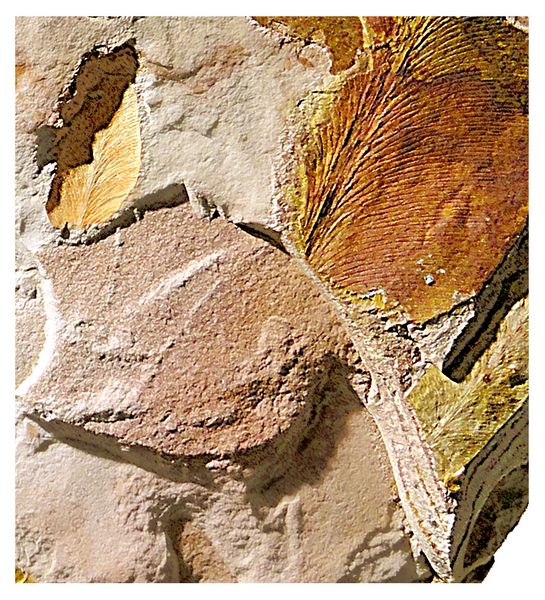 The Triassic, as the first period of the Mesozoic era, lasted for 51
million years (251.2 - 201.3 mya). It represents a severe
reduction in species, following the mass extinction at the end of the
Permian Period. Only about 4 % of the world's marine species, and an
estimated 30% of terrestial species, survived the
Permian-Triassic Mass Extinction (Benton 2005; Sahney and Benton 2008).
Also occurring was the only known mass extinction of insects, with 57%
of all insect families and 83% of all insect genera becoming extinct
(Labandeira and Sepkoski 1993).
The Triassic, as the first period of the Mesozoic era, lasted for 51
million years (251.2 - 201.3 mya). It represents a severe
reduction in species, following the mass extinction at the end of the
Permian Period. Only about 4 % of the world's marine species, and an
estimated 30% of terrestial species, survived the
Permian-Triassic Mass Extinction (Benton 2005; Sahney and Benton 2008).
Also occurring was the only known mass extinction of insects, with 57%
of all insect families and 83% of all insect genera becoming extinct
(Labandeira and Sepkoski 1993).A majority of dominant land plant species also disappeared. Glossopterids (fig.1) were one of the major casualties of the end- of-Permian, mass extinction event. The Glossopterid family, which arose in the Southern Hemisphere by the Early Permian period, became the dominant elements of the southern flora through the rest of the Permian. Glossopteris was a woody, seed-bearing tree, growing as high as 30 meters, which thrived in very wet soil conditions. Fossils of Glossopteris have been found in all of the southern continents then joined together as Gondwanaland, with over 70 fossil species recognized in India alone, and other species known from Africa, Madagascar, Australia, Antarctica, and South America. At the end of the Permian they became completely extinct.
Fig.6: Fossilized leaves and stem from the Permian tree Glossopteris.
Direct effects of the Permian-Triassic extinction lasted at least through the Early Triassic, a period of five million years. The mass extinction was probably caused by a combination of volcanic activity (fig.2), global warming, and increasingly arid climate in the mega-continent Pangea (fig.3). At the the start of the Early Triassic, during the Induan stage (252-251 mya), all continental plates were joined into Pangea except China, Indonesia, and the Cimmerian zone including Thailand and parts o
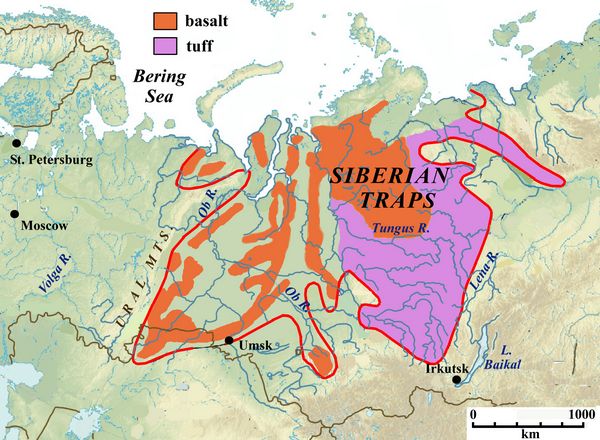 f Turkey, the latter areas being islands
in the Tethys Sea.
f Turkey, the latter areas being islands
in the Tethys Sea.Regarding volcanism as a likely cause of radical atmospheric changes, much attention has been paid to evidence provided by the extensive lava fields known as the Siberian Traps (fig.2) , a vast basaltic area in Russian Siberia extending for about 3000 km. The Siberian Traps indicate massive volcanism which occurred between 252.6 and 250.3 mya, starting at the very end of the Permian, and lasting through the initial Induan Stage and part of the Olenikian stage of the Early Triassic (Kump et al. 2005; Knoll et al. 2007; Ogdena and Sleep 2011).
Fig.7: Siberian Traps region of Russia.
The Siberian Traps consist primarily of basalt and tuff formations. The term "traps" is derived from "trappa", the Swedish word for stairs, referring to the step-like hills of the region, which were created by massive outpourings of lava that hardened into basalt. The major eruptive events which formed the traps, the largest known over about 500 million years since the Cambrian period, are thought to have resulted not only in the extensive outpourings of lava forming the basalt traps, but also frequent explosions and coal/gas fires with significant impact on the atmosphere. In combination, these released enough acid and carbon dioxide over an extended period, to have critically damaged both the marine environment and the Earth's atmosphere and its vegetation.
 Evidence suggests that equatorial temperatures exceeded the
thermal tolerance for many marine
vertebrates over a long period, spanning at least two thermal maxima,
whereas terrestrial equatorial temperatures were sufficiently severe to
suppress plant and animal abundance during most of the Early
Triassic (Sun et al 2013). Consequences included atmospheric and
oceanic warming by 510° C, anoxia in the oceans, and acid rain leading
to massive killing of forests. Most damaging to marine life forms were
acidification and anoxia (Knoll et al., 2007); while on land,
most harm was caused by acid rain and an increasingly arid climate
(Benton and Newell, in press; Benton et al. 2013)
Evidence suggests that equatorial temperatures exceeded the
thermal tolerance for many marine
vertebrates over a long period, spanning at least two thermal maxima,
whereas terrestrial equatorial temperatures were sufficiently severe to
suppress plant and animal abundance during most of the Early
Triassic (Sun et al 2013). Consequences included atmospheric and
oceanic warming by 510° C, anoxia in the oceans, and acid rain leading
to massive killing of forests. Most damaging to marine life forms were
acidification and anoxia (Knoll et al., 2007); while on land,
most harm was caused by acid rain and an increasingly arid climate
(Benton and Newell, in press; Benton et al. 2013) Fig.8: Pangaea at the start of the Early Triassic Period (Induan Stage).
.
The Early Triassic fossil record.
Overall, Early Triassic vertebrates are best represented in the Beaufort Group of South Africa's Karoo Basin; and secondly, in the Vetluga series in the Buskunchyak of Russia. Both regions have continuous successions of Permian to Early Triassic therapsids. In South Africa, postdating the Late Permian fossil deposits of the Balfour formation, are extensive Early Triassic deposits, including the Lystrosaurus Assemblage Zone in the Katberg Formation, and the Cynognathus Assemblage zone in the Burgersdorp formation.
Other components of the Early Triassic fossil record occur in China, in the Heshanggou and Livijagou formations of Shansxi and Inner Mongolia, and the Shaofanggou and Jiucaiynan Formations of Xinjiang province in the northwest. (These are covered in a later section.)
Early Triassic vertebrates are also recorded in the Puesto Viejo formation of Argentina, equjivalent to the Mendoza formation in Brazil. Other, comparable Early Triassic vertebrate fossils from the Gondwana conjunction of southern continents have been found in the Arcadia Formation of Australia, and the Fremouw Formation of Antartica.
During the Early Triassic, Induan and Ikenikian stages (252-247 mya) some entirely new groups of large aquatic vertebrates appeared, as evidenced by findings in the Yunnan and Ghouzou deposits in south China and elsewhere (Benton et al. 2013). This included first major radiation of marine reptiles, including ichthyosaurs, sauropterygians, and thalattosaurs. In the Permian, there had been only a short-lived expansion of marine reptiles around the southern shores of Gondwanaland. These late Paleozoic marine reptiles are collectively called mesosaurs, a mixed grouping which includes various unrelated taxa (McGowan and Motani, 2003).
While many families of fish disappeared in the massive marine extinction, during the Early Triassic there was a large radiation of bony fish, especially the actinopterygians or spiny-fin groups. Marine invertebrates also saw major changes. The most common Paleozoic groups such as brachiopods, trilobites, and rugose and tabulate corals all became extinct, to be replaced during the Early and Middle Triassic (252-235 mya) by echinoderms, mollusks (both bivalves and gastropids), arthropods, ammonites, and scleractinian corals (Benton et al. 2013).
Lystrosaurus zones
On land, many groups of vertebrates disappeared during the end-of-Permian extinction, to be replaced by new forms. For Early Triassic land vertebrates, two main patterns occurred throughout the continental land mass called Pangaea (Colbert 1973; Sun 1980). One consisted mainly of labyrinthodont amphibians, with little evidence of reptiles except occasional trace fossils (i.e., footprints) of smaller reptiles such as Chilotherium. This condition existed in a portion of Laurasia from Greenland to Spitzbergen to North America, and Madagascar, which was then landlocked in the midst of Pangaea.
The second pattern, much more widely distributed in the southern Pangean region of Gondwanaland, comprising South Africa, India, China, Australia, Antartica, and Russia, included both amphibians and a standard assemblage of reptiles and synapsids known as the Lystrosaurus fauna, after the Early Triassic faunal zone of that name in the South African Karoo Basin. Lystrosaurus (fig.9) was an herbivorous synapsid of the widespread dicynodonts. With only two upper canines, their name means "two dog-teeth". Lystrosaurus fossil species are very similar throughout the regions where they migrated. The associated environments for this small, terrestial plant-eater are wooded, well-watered, riverine settings. In Gondwanaland, this pattern may have carried over from the Late Permian, when the d
 istribution of dicynodonts accords well with that of forest
vegetation, as shown by Glossopteris distribution.
istribution of dicynodonts accords well with that of forest
vegetation, as shown by Glossopteris distribution.The Early Triassic strata in the Beaufort Group of South Africa have been separated into two sequential fossils zones: the lower Lystrosaurus Zone, correponding to the earliest part of the Early Triassic, and the upper Cynognathus Zone, at the end of the Early Triassic. Originally, there was a third intermediate zone, named the Procolophonid zone for common small anapsid reptiles. This, however, was later merged with the earlier Lystrosaurus zone, as the two type taxa, Procolophon and Lystrosaurus, proved to be largely contemporary (Broom; Kitching J.W.; Sun 1980).
Fig.9: Lystrosaurus, a small herbivorous dicynodont common throughout Pangea in the Early Triassic.
Procolophonoids (fig.4) were anapsid reptiles who also have a very wide Early Triassic distribution, their fossils having been found in North America, Europe, China, Russia, Africa, and Antarctica. Their affinities have long been debated. Some consider them to be closely related to turtles, as shown by the presence of a large posttemporal fenestra or opening in the back of the skull for jaw muscle attachment (Reisz and Lauren 1991). All known Late Permian and some Early Triassic procolophonoids had sharp teeth, and were either insectivorous or carnivorous. Later forms from the Middle and Late Triassic, however, have broad, bulbous teeth that indicate a herbivorous diet. Upper Triassic procolophonoids include Hypsognathus, which has a much enlarged eye orbit on the posterior end. The presence of a slender stapes (a sound-conducting middle ear ossicle) in a groove of the quadrate bone near the lower jaw joint indicates that procolophonoids had a tympanum or ear drum and could hear some high frequency airborne sounds. Primitive traits shared by all procolophonoids include a pineal foramen, a large hole between the orbits now lost in extant anapsid reptiles.
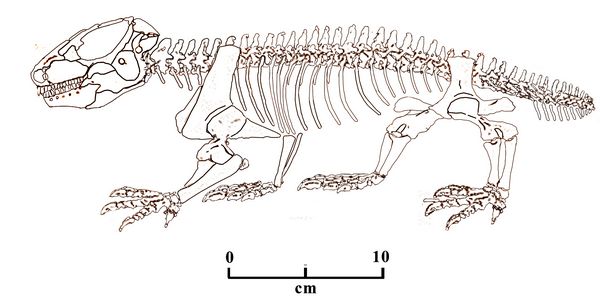 Fig.10: Procolophon, a small anapsid reptile that was widespread in
Pangea during the Early
Triassic.
Fig.10: Procolophon, a small anapsid reptile that was widespread in
Pangea during the Early
Triassic. Findings of the anapsid Procolophonis in the Early Triassic Fremouw Formation of Antarctica has helped establish faunal distribution in Gondwanaland, the southern half of Pangea. The Antarctic fossils were all identified as Procolophon trigoniceps Owen, typically also found in the Lystrosaurus Zone in South Africa. The presence of this particular species in both Africa and Antarctica provides further evidence of widespread distribution in Gondwanaland of Lystrosaurus, and also indicates close links between the two continents at the beginning of the Mesozoic (Colbert and Kitching 1975).
Another successful Early Triassic reptile group were the archosaurs, diapsids 1-3 meters in length who were present in modest numbers in the latest Permian, then expanded considerably in the Early Triassic. Protorosaurus ("first lizard"), a lizard-like reptile about two meters long who had lived in the area of Germany during the Late Permian, is the earliest known archosauromorph.
One of the most common archosaurs in the Early Triassic, and one of the largest, was Proterosuchus, associated with the Lystrosaurus faunal complex in both South Africa and China. The type species is Proterosuchus fergusi, first described by Rober
 t Broom in 1903 from the Beaufort Group in South Africa (Broom
1903). It was about the same size as a Komodo Dragon (2-3 meters long),
and somewhat resembled a crocodile both in appearance, and in its
living, hunting, and eating habits. A Chinese variant of Proterosuchus is named Chasmatosaurus, which is
also linked with the Lystrosaurus fauna in the Early Triassic Heshankou
formation in Shanxi Province, in northeast China (Sun 1980).
t Broom in 1903 from the Beaufort Group in South Africa (Broom
1903). It was about the same size as a Komodo Dragon (2-3 meters long),
and somewhat resembled a crocodile both in appearance, and in its
living, hunting, and eating habits. A Chinese variant of Proterosuchus is named Chasmatosaurus, which is
also linked with the Lystrosaurus fauna in the Early Triassic Heshankou
formation in Shanxi Province, in northeast China (Sun 1980).Fig.x: Skull of Proterosuchus fergosi (after Foth et al ).
Proterosuchus was one of the largest land reptiles during the Early Triassic period, reaching a length of 3.5 m. Its habits were mainly riverine, and its hunting and predatory practices were probably similar to those of crocodiles. Its skull was large, with a downward curve in the premaxilla, and a formidable array of teeth used in hunting and tearing prey. In its expanded premaxilla were sharp, conical teeth, which extends downward like a scoop, and effectively extends reach of the upper jaw.The premaxilla had up to nine teeth on each side, with 59 more teeth on each side in the maxilla and dentary (upper and lower jaws). As in most archosauriforms, all the teeth of Proterosuchus were curved and serrated, and of the same pointed shape.
Proterosuchus spent most of its time in rivers or estuaries, but could also walk on land. At first it was considered to have been a direct ancestor of modern crocodiles, but it is now understood to be more basal (i.e., it is ancestral to a series of archosaurs, that eventually led to crocodiles, dinosaurs, and birds).
Another related archosaur is Tasmaniasaurs triassicus, first discovered in 1960 in Hobart, Tasmania on the southeast coast of Australia, and recently identified as a probable member of the Proterosuchidae family, with similarities in its premaxilla and dentition to P. fergosi (Ezcurra 2014). Recovered were skeletal parts and a partial skull, which has provided a partial cranial endocast, the first for Proterosuchidae. This revealed structures related to the olfactory bulb, the brain section associated with the nasal passages and the sense of smell.
References:
Anderson and Cruikshank 1978
Benton, M.J. 2005 . When life nearly died: the greatest mass extinction of all time. London: Thames & Hudso
Boonstra, L. D. 1938. "A report of some Karoo reptiles from the Luangwa Valley, Northern Rhodesia" Quaternary Journal of the Geological Society of London 94, pp. 371-384.
Boos, A. D. S.; Schultz, C. L.; Vega, C. S.; Aumond, J. S. J. (2013). "On the presence of the Late Permian dicynodont Endothiodon in Brazil". In Angielczyk, Kenneth.
Broom, R. 1903. "On a new reptile (Proterosuchus fergusi) from the Karroo beds of Tarkastad, South Africa". Annals of the South African Museum 4: 159164.
Broom, R. 1915
Colbert, E.H. 1973 "The Labyrinthodont-Chilotherium Complex."
Colbert, E.H. and J.W. Kitching 1975 "The Triassic reptile Procolophon in Antarctica." American Museum Novitates no. 2566.
Ezcurra, M.D. 2014 "The Osteology of the Basal Archosauromorph Tasmaniosaurus triassicus from the Lower Triassic of Tasmania, Australia". PloS One 9(1)
Gauthier, J., A. G. Kluge, and T. Rowe. 1988. The early evolution of the Amniota. In: M. J. Benton (ed.) The phylogeny and classification of the tetrapods, Volume 1: amphibians, reptiles, birds: 103-155. Oxford: Clarendon Press.
Haughton, S. H. (1917). "Investigations in South African fossil reptiles and Amphibia. Part 10. Descriptive catalogue of the Dicynodontia." Annals of the South African Museum 12, pp.127-174.
Keyser, A. W. (1975). "A re-evaluation of the cranial morphology and systematics of some tuskless Anomodontia." Memoir of the Geological Society of South Africa 67, pp.1-110.
King, 1990.
King, 1992.
Knoll, A.H., R.K Bambach, J.L Payne, S. Pruss, and W.W Fischer, 2007. Paleophysiology and end-Permian mass extinction. Earth and Planetary Science Letters 256 (34): 29531
Kump, L., A.Pavlov and M. A. Arthur 2005 . Massive release of hydrogen sulfide to the surface ocean and atmosphere during intervals of oceanic anoxia. Geology 33, pp.397400.
Labandeira C.C., and J.J. Sepkoski 1993. Insect diversity in the fossil record. Science 261 (5119), pp. 310315.
Mazin, J. M. and King, G. M. (1991). "The first dicynodont from the Late Permian of Malagasy." Palaeontology 34, pp.837842.
Owen, R. 1860. "On some reptilian fossils from South Africa." Quaternary Journal of the Geological Assotiation of South Africa 67, pp.1-110.
Ogdena, D. E. and N. H. Sleep 2011. Explosive eruption of coal and basalt and the end-Permian mass extinction.. Proceedings of the National Academy of Sciences of the USA.
Sahney, S. and M.J. Benton 2008. Recovery from the most profound mass extinction of all time. Proceedings of the Royal Society B 275 (1636), pp.75976.
Sun, Y., W. Joachimski, C. Yan, W. Jiang,and L. Wang, 2013.Lethally Hot Temperatures During the Early Triassic Greenhouse. Science 338: pp. 36670.
Surkov, M.V.; and Benton, M.J. (2008). "Head kinematics and feeding adaptations of the Permian and Triassic dicynodonts". Journal of Vertebrate Paleontology 28 (4): 11201129.
Univ. of Calif. Paleontology website, 2014a "Protocolophon".
Glossary